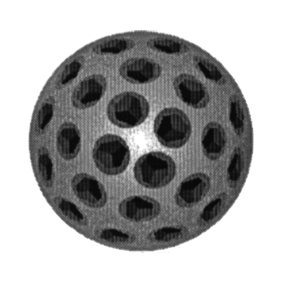GFZ-1
| GFZ-1 | |
|---|---|

|
|
| Type: | Research satellite |
| Country: |
|
| COSPAR-ID : | 1986-017JE |
| Mission dates | |
| Dimensions: | 21 kg |
| Size: | 22 cm diameter |
| Begin: | suspended: April 19, 1995 |
| Starting place: | Space station Mir |
| Status: | burned up on June 23, 1999 |
| Orbit data | |
| Orbit inclination : | 51.6 ° |
| Apogee height : | 387 km |
| Perigee height : | 380 km |
The German research satellite GFZ-1 , launched in 1995, was an inexpensive development by the GeoForschungsZentrum Potsdam , which was developed in less than a year together with Russian partners and the Kayser-Threde company . The microsatellite was in use as planned from 1995 to 1999 and, measured against the cost of less than one million DM, one of the most successful missions in unmanned space travel.
construction
GFZ-1 was a 20.6 kg, passive, laser satellite with a diameter of 22 cm. Its spherical surface carried 60 laser retroreflectors in order to carry out measurements for geometric and physical methods of satellite geodesy . The lifespan of the satellite was estimated at 3.5 to 5 years, as the orbit height of each low satellite slowly sinks due to the braking effect of the high atmosphere . The size of this rate of descent cannot, however , be precisely predicted , mainly because of the irregular solar activity .
function
He served as a high target for accurate laser - distance measurements of special SLR ground stations ( Satellite Laser Ranging ). Based on the experience gained with GFZ-1, the GeoForschungsZentrum developed a much more accurate successor - the geophysical satellite CHAMP, which was launched in August 2000 . Despite its relatively small size, it is no longer just a reflecting satellite, but uses "active" methods (microwaves, measuring probes and analyzes of its orbital elements) to measure the earth's gravity field , the magnetic field and some parameters of solar activity.
history
The microsatellite was brought to the Mir space station on April 9, 1995 by a Russian Progress M-27 transporter. From there it was launched ten days later into a low polar orbit at an altitude of 400 km. According to the rules of the Committee on Space Research (COSPAR), GFZ-1 was considered a fragment of the Mir and was given the astronomical designation 1986-017JE derived from it , which gives the launch year as 1986, although the satellite was not launched into Earth orbit until 1995.
The first LASER observation of the satellite, which could hardly be seen with the naked eye due to its small size, was made at the Graz-Lustbühel laser station just 32 minutes after the separation from the Mir space station (over Chile) on April 19, 1995 at 19 : 45 UTC. However, it was still imprecise due to the difficult circumstances. The first good series of measurements was made four and a half hours later (00:19 UTC) by the US station Greenbelt (Maryland) on the fourth orbit at an altitude of 398 km. The last measurement was carried out by the Yarragadee station in Australia at orbit No. 23718 at an altitude of only 230 km, a few hours before it burned up.
GFZ-1 burned up in the earth's atmosphere on June 23 , 1999 after having circled the earth almost 24,000 times. The lifespan of four years and 64 days corresponded to the mean of the predicted key data. A total of 5,402 satellite passages were measured with laser beams, which is a high success rate in view of the weather dependency. 33 ground stations of the worldwide SLR network were involved in these approx. 1 cm accurate distance measurements , including the GFZ's own satellite station in Potsdam and the closely cooperating stations near Graz (Austria) and Zimmerwald (Switzerland).
Individual evidence
- ↑ a b Spacewarn Bulletin 499. (No longer available online.) NASA, May 25, 1995, archived from the original on February 17, 2013 ; accessed on October 4, 2012 (English): "1986-017JE GFZ 1 is a German microsatellite which was released from the Russian MIR station. It carries reflectors for laser-ranged, gravitational studies. Its orbital parameters are presumed to be close to those of MIR. The international ID is a derivative of the MIR ID, 1986-017A. " Info: The archive link was automatically inserted and not yet checked. Please check the original and archive link according to the instructions and then remove this notice.
- ↑ GFZ-1 in the Encyclopedia Astronautica , accessed on October 4, 2012 (English).